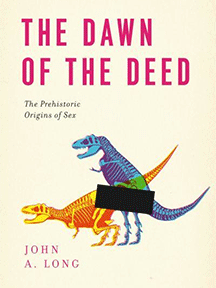Given these remarkable discoveries, Long’s primary concern here is the question of what adaptations of mating practices enabled internal fertilization as opposed to the external fertilization or spawning practiced by most species of living fish. Female readers may well be disaffectedly annoyed to discover that despite the gravid piscine fossils, Long’s almost exclusive focus is on the sperm-delivery system from the basipterygium (basal claspers) of Carcharodonta (sharks, skates, rays) to the aedegus of insects to the mammalian penis. In the fossil record this focus is justified since the proto-penal structures of sharks and placoderms, because comprised of bones (homologous to the os baculum or penis bone of many mammals), survived in the paleontological record.
Long also provides an interesting account of how science works as well as a narrative of his own exploratory expeditions, the international collaborations that led to the discoveries he describes, and a lucid description of the interrelationship among paleontology, comparative anatomy, and evolutionary theory. In the final quarter of the text he provides a summary of recent work in “evo-devo” (evolutionary developmental biology), noting that Homeobox (Hox) genes that control the embryonic development of legs also control the development of the penis, and that the evolution of jaws was initially to facilitate mating and only secondarily became an aid to ingurgitation. In the course of surveying the varieties of penal structures, many armored and equipped with barbs, spikes, spines and knobs that facilitate sperm competition, Long again considers the struggle of the male to insure spermatic transfer and ignores the complementary recent investigations of polyandry and female sperm choice (see Tim Birkhead, Promiscuity: An Evolutionary History of Sperm Competition [Harvard University Press, 2000]).
Popular in tone and by turns scientifically fascinating and jocularly titillating, Dawn effectively demonstrates that human sexuality both evolutionarily and behaviorally is intimately connected to the totality of the zoological phyla, as evidenced by the presence of homosexuality, oral and anal intercourse, cross-dressing, and sex changes among diverse fauna. Long offers a compelling reading of the origins of eukaryotic sex, but the broader questions of how or why it evolved remain to be solved.
Readers seeking a more scholarly treatment of these matters might well consult two articles Long co-authored for Nature: “Live Birth in the Devonian Period,” (29 May 29, 2008) [Materpiscis attenbourghi], and “Devonian Arthrodire Embryos and the Origin of Internal Fertilization in Vertebrates,” (February 28, 2009) [Incisoscutum ritchiei]. More technically oriented, both provide more scientific data and excellent tomographic photographs of the original fossil finds revealing these organisms’ sexual characteristics.
Louis J. Kern (ΦBK, Clark University,1965) is professor emeritus of history at Hofstra University. Hofstra University is home to the Omega of New York chapter of Phi Beta Kappa.




